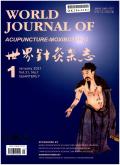Effects of moxibustion at different temperature on wound healing and apoptosis in rats with pressure ulcer based on PI3K/AKT/mTOR signal pathway
IF 1.3
4区 医学
Q4 INTEGRATIVE & COMPLEMENTARY MEDICINE
引用次数: 0
Abstract
Objective
To investigate the effects of moxibustion on wound healing and evaluate whether the efficacy of moxibustion at different temperatures varies. Additionally, to explore the mechanism by which moxibustion regulates the phosphatidylinositol 3-kinase (PI3K)/protein kinase B (AKT)/mammalian rapamycin target protein (mTOR) signaling pathway on wound healing and cell apoptosis.
Methods
A total of 90 SPF-grade SD rats were randomly divided into six groups (15 rats per group): control group, model group, recombinant bovine basic fibroblast growth factor gel (rb-bFGF) group, moxibustion group A [temperature (42 ± 1) °C], moxibustion group B [temperature (45 ± 1) °C], and moxibustion group C [ temperature (48 ± 1) °C]. Except the control group, the interventions were conducted in the other groups with pressure ulcer induced by ischemia/reperfusion injury. In the control group, povidone-iodine was administered at the knee joint. In the model group, after povidone-iodine applied at the pressure ulcer, petroleum jelly gauze was bandaged. In the rb-bFGF group, after povidone-iodine applied at the pressure ulcer, rb-bFGF was smeared and petroleum jelly gauze was bandaged. In the moxibustion group A, the suspending moxibustion with moxa stick was delivered 3 cm to 5 cm above the ulcer. The paperless temperature recorder probe was placed on the wound surface where moxibustion was delivered, and the real-time temperature was monitored and adjusted, kept at (42 ± 1) °C. The moxibustion temperature was kept at (45 ± 1) °C in the moxibustion group B, and (48 ± 1) °C in the moxibustion group C. The intervention lasted 14 days in each group. The wound healing rates were compared on the 3, 5, 7 and 14 days after the first intervention among the 6 groups. After 14-day intervention respectively, the histopathological changes were observed with HE staining, apoptosis was detected with TUNEL method and flow cytometry; VEGF-A protein expression determined with immunohistochemistry; the contents of Interleukin-6 (IL-6), tumor necrosis factor-α (TNF-α) and transforming growth factor-β (TGF-β) in serum with ELISA, and PI3K/AKT/mTOR related protein and mRNA expression was with Western blotting and qRT-PCR in wound tissues of each group.
Results
Regarding the intervention effects, (1) compared with the control group, the model group showed significant inflammatory infiltration in wound tissues, higher levels of cell apoptosis, and elevated serum levels of IL-6, TNF-α and TGF-β (P < 0.05); (2) compared with the model group, the rb-bFGF group and 3 moxibustion groups showed higher wound healing rates (P < 0.05), reduced inflammatory infiltration in the wound tissues, lower levels of cell apoptosis, and decreased serum levels of IL-6, TNF-α and TGF-β (P < 0.05). Among the moxibustion groups, group C showed significantly better results than group A (P < 0.01). Regarding the mechanism, (1) compared with the control group, the model group exhibited significantly higher protein and mRNA expression levels of PI3K/AKT/mTOR signal pathway components (P < 0.05); (2) compared with the model group, the rb-bFGF group and 3 moxibustion groups showed lower protein and mRNA expression levels of PI3K/AKT/mTOR signal pathway components (P < 0.05). Among the moxibustion groups, group C showed significantly higher expression levels than group A (P < 0.01).
Conclusion
Moxibustion significantly promotes wound healing, with high-temperature moxibustion being more effective than low-temperature moxibustion in reducing the expression of inflammatory factors and cell apoptosis, thereby improving wound healing rates. It is presented that the higher moxibustion temperature, the higher wound healing rate, which may be associated with the regulation of PI3K/AKT/mTOR signal pathway with moxibustion.
基于PI3K/AKT/mTOR信号通路的不同温度艾灸对压疮大鼠创面愈合及细胞凋亡的影响
目的探讨艾灸对创面愈合的影响,评价不同温度下艾灸对创面愈合的影响。此外,探讨艾灸调节磷脂酰肌醇3-激酶(PI3K)/蛋白激酶B (AKT)/哺乳动物雷帕霉素靶蛋白(mTOR)信号通路在创面愈合和细胞凋亡中的作用机制。方法90只spf级SD大鼠随机分为6组(每组15只):对照组、模型组、重组牛碱性成纤维细胞生长因子凝胶(rb-bFGF)组、艾灸组A[温度(42±1)℃]、艾灸组B[温度(45±1)℃]、艾灸组C[温度(48±1)℃]。除对照组外,对缺血再灌注损伤致压疮组均进行干预。对照组在膝关节处给予聚维酮碘。模型组在压疮处应用聚维酮碘后,包扎凡士林纱布。rb-bFGF组在压疮处应用聚维酮碘后,涂抹rb-bFGF,包扎凡士林纱布。艾灸A组在溃疡上方3cm ~ 5cm处用艾条悬灸。将无纸化测温探头置于施灸创面,实时监测并调节温度,保持在(42±1)℃。艾灸B组保持(45±1)℃,艾灸C组保持(48±1)℃,每组干预14 d。比较6组患者首次干预后第3、5、7、14天创面愈合率。干预14d后,分别采用HE染色观察组织病理变化,TUNEL法和流式细胞术检测细胞凋亡;免疫组化法测定VEGF-A蛋白表达;ELISA法检测各组创面组织血清中白细胞介素-6 (IL-6)、肿瘤坏死因子-α (TNF-α)和转化生长因子-β (TGF-β)含量,Western blotting法和qRT-PCR法检测各组创面组织中PI3K/AKT/mTOR相关蛋白及mRNA表达。结果干预效果方面,(1)与对照组比较,模型组创面组织炎症浸润明显,细胞凋亡水平升高,血清IL-6、TNF-α、TGF-β水平升高(P <;0.05);(2)与模型组比较,rb-bFGF组和3个艾灸组创面愈合率均较高(P <;0.05),创面组织炎症浸润减少,细胞凋亡水平降低,血清IL-6、TNF-α、TGF-β水平降低(P <;0.05)。艾灸组中,C组疗效显著优于A组(P <;0.01)。机制方面,(1)与对照组相比,模型组PI3K/AKT/mTOR信号通路组分蛋白及mRNA表达水平显著升高(P <;0.05);(2)与模型组比较,rb-bFGF组和3个艾灸组PI3K/AKT/mTOR信号通路组分的蛋白和mRNA表达水平均较低(P <;0.05)。艾灸组中,C组表达量显著高于A组(P <;0.01)。结论艾灸能显著促进创面愈合,高温艾灸比低温艾灸更能降低炎症因子表达和细胞凋亡,从而提高创面愈合率。提示艾灸温度越高,创面愈合速度越快,这可能与艾灸对PI3K/AKT/mTOR信号通路的调节有关。
本文章由计算机程序翻译,如有差异,请以英文原文为准。
求助全文
约1分钟内获得全文
求助全文
来源期刊

World Journal of Acupuncture-Moxibustion
INTEGRATIVE & COMPLEMENTARY MEDICINE-
CiteScore
1.30
自引率
28.60%
发文量
1089
审稿时长
50 days
期刊介绍:
The focus of the journal includes, but is not confined to, clinical research, summaries of clinical experiences, experimental research and clinical reports on needling techniques, moxibustion techniques, acupuncture analgesia and acupuncture anesthesia.
 求助内容:
求助内容: 应助结果提醒方式:
应助结果提醒方式:


